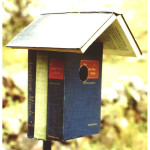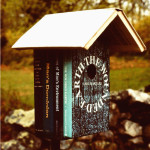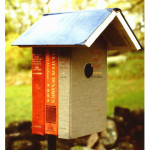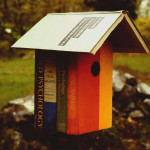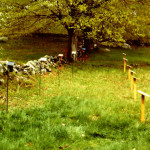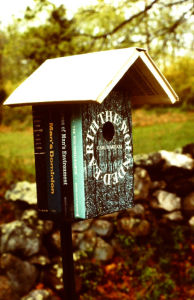The Bluebird consisted of two sites, one facing north from the Connemara Conservancy, TX and the other facing south from Weir Farm, CT (roughly the year-round range of the Eastern Bluebird). Each site contained six birdhouses made from social science texts on human psychology, American values, and land use facing six poems about the bluebird as the farmer’s friend and the harbinger of spring—the earth on its belly and the sky on his back. Mounted in two sites threatened by suburban sprawl, this installation explores our romantic notions about nature and issues around habitat destruction and species displacement.
The cluster of books in the 6 houses at Weir Farm
- Birdhouse #1: Our American Land • Living on a Few Acres • That We May Eat • Contours of Change • Science for Better Living
- Birdhouse #2: The American Spirit • The American Way of Life • The American Gospel of Success • American Minds
- Birdhouse #3: The Greening of America • The Wounded Earth • The Fitness of Man’s Environment • Man’s Dominion • Environment and Change: The Next Fifty Years
- Birdhouse #4: Social Psychology • Housing and Society • Population Dynamics • The Population Crisis and the Use of World Resources
- Birdhouse #5: Nature, Human Nature, and Society • Exploring New Ethics for Survival • The Principles of Christian Ethics • Ethics and the Human Community • A Modern Introduction to Ethics
- Birdhouse #6: Toward Understanding Human Personalities • The Imperial Animal • The Psychology of Human Development • The Vital Balance • Applied Psychology
The 6 bluebird poems (to read the poem click on the title):
- The Bluebird by John Burroughs
- The Bluebird by Emily Huntington Miller
- The Bluebird by Eben Eugene Rexford
- The Blue-Bird by Alexander Wilson
- An Early Bluebird by Maurice Thompson
- The First Bluebird by James Whitcomb Riley
Artist note: Charles Bukowski offers another type of Bluebird Poem that could speak to this piece on another level.
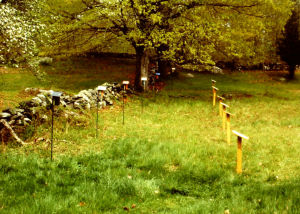 “This summer, visitors to Weir farm have encountered a row of bluebird houses made out of textbooks facing a row of podiums displaying romantic poems about nature, spring and the bluebird. The Bluebird is the first site installation by 1993-94 Visiting Artist, Charles McQuillen.
“This summer, visitors to Weir farm have encountered a row of bluebird houses made out of textbooks facing a row of podiums displaying romantic poems about nature, spring and the bluebird. The Bluebird is the first site installation by 1993-94 Visiting Artist, Charles McQuillen.
This site installation is one of a pair, the other being in southern Texas—two stops on the annual migration of the Eastern Bluebird. Although both sites provide critical habitat for a range of wildlife, the bad news is that the bluebird population has decreased drastically, by almost 90% in the last 60 years. The main culprits are the destruction of habitat, changing agricultural practices, and the introduction of the European starling to North America.
The colorful birdhouses attracted several bluebirds, adding a new dimension to the installation and extending the exhibit.…”
– Angevin. Susan. “Sculptor Blends Art with Environmentalism,”
Weir Farm News. Wilton, CT. Fall, 1995.
“Sculptor Charles McQuillen’s contribution to the exhibition covers a 1,500-mile span from Texas [to Weir Farm, CT].…The six bluebird houses made from hollowed-out textbooks face a line of six podiums containing six sentimental poems that celebrate the bluebird as the harbinger of spring. McQuillen, who works for Houghton Mifflin Publishers in Boston, writes of the experience, “I am inspired by the site’s raw materials, its history and social function. While every environment contains these components, at Weir Farm they possess an added significance. Through J. Alden Weir’s artwork, an open field or dilapidated stone wall evokes grander ideals or universal concerns. This added dimension makes Weir Farm a richer more reverent site in which to work.”
– Tyler, Betty. “Impressions of Weir Farm: Four Artists See 1890s Landscape in a New Light,”
The Voice. Norwalk, CT. July 14, 1995.
While I had long worked with the natural elements, this was the first piece in which I collaborated with living creatures. Since it is never good form to hurt living creatures in an environmentally sensitive installation, I took special precautions to protect the bluebirds that would nest in the houses. I designed the house cavities to bluebird-habitat specifications and designed a hidden inner armature that would hold the houses together for the entire nesting season no matter the weather conditions. I used nontoxic glues and sealants to keep out the rain. The planning and preparation around this piece was a far cry from my impromptu guerrilla installations. The added effort was well worth it. When bluebirds took up residence in the houses and watched viewers read the poems it added a level of intrigue and dynamism to the piece that I could have only hoped for.
- Have students access the bluebird poems via their embedded links. Discuss the poems’ shared imagery and symbolism. The book titles in each house were carefully clustered. What kinds of thoughts and feelings do these book-spine poems evoke?
- Analyze the pictures of the piece and the brief description. What does the juxtaposition of the birdhouses and the poems make the viewer think about? Access the links to the two sites, the Connemara Conservancy, TX and Weir Farm, CT. How do these sites inform its meaning?
- Read the reviews. Have the reviews changed your view of the piece?
- How might the experience of viewing the piece in person enhance your understanding of the installation?
See Silent Suburb for another installation that builds on the birdhouse imagery. See Landscape Paintings for another Weir Farm installation.
If your students are interested in artists whose work views the world through an animals’ eyes introduce them to David Maisel and Sam Easterson. For artists who make animal habitats see Yolanda Gutierrez and Lynne Hull.
If your students have an affinity for environmental poetry you could direct them to learn more about ecopoetry. Also introduce your students to Robert Hass, Jorie Graham, and Marianne Moore. If your students were intrigued by the idea of book-spine poetry share these high-quality inspirational book-spine poems.


